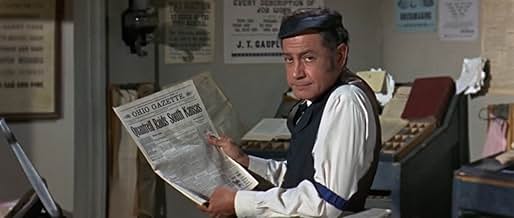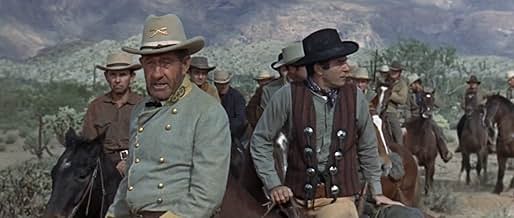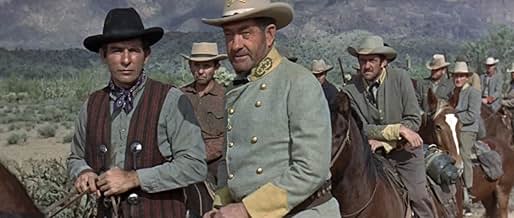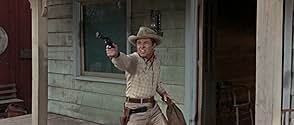IMDb RATING
5.9/10
1.3K
YOUR RATING
When Quantrill's (Quantrell) gang is almost destroyed two of the captured members agree to join the Arizona Rangers to help finish the job.When Quantrill's (Quantrell) gang is almost destroyed two of the captured members agree to join the Arizona Rangers to help finish the job.When Quantrill's (Quantrell) gang is almost destroyed two of the captured members agree to join the Arizona Rangers to help finish the job.
Willard W. Willingham
- Eddie
- (as Willard Willingham)
Boyd 'Red' Morgan
- Tex
- (as Red Morgan)
Booth Colman
- Ohio Gazette Editor
- (uncredited)
Robert Shelton
- Jim
- (uncredited)
Featured reviews
This movie is a remake of the 1951 movie "The Texas Rangers", same plot, same storyline, same lines. Only the locale and the actors are different. I take that back, this time it wasn't just a couple of men who were removed from prison, they were moved from state to state.
Having said that, I did enjoy the movie. There were enough changes to make it interesting. Audie Murphy did a wonderful job in the lead role. The location was beautiful. The director did a good job in making this movie stand on it's own.
If you liked the earlier movie, you will enjoy this remake. Audie Murphy fans should enjoy seeing him in this.
Having said that, I did enjoy the movie. There were enough changes to make it interesting. Audie Murphy did a wonderful job in the lead role. The location was beautiful. The director did a good job in making this movie stand on it's own.
If you liked the earlier movie, you will enjoy this remake. Audie Murphy fans should enjoy seeing him in this.
His raiders are broken up and Quantrill dies in an army hospital. Audie Murphy is sentenced to death, but the sentence is commuted to 20 years on the recommendation of Buster Crabbe, who led the attack on them. Crabbe winds up leading the Arizona Rangers. There the remnants Quantrill's forces have retreated, to become outlaws. The government can't figure out where they are, where they will strike, but he comes up with a plan: release Murphy, induct him into the Rangers and set him after the bad guys.
Audie Murphy had moved surely into westerns after he became the most decorated American soldier in the Second World War and had prospered. He was getting on in years, and the genre westerns were beginning to disappear. This movie was an attempt by him and director William Witney to produce something epic and mythic. It begins with a recitation of Quantrill's history, and moves in action. There are many nice touches: Murphy's conflicted position, the beautiful Indian girl played by Gloria Talbott, the importance of oaths, the stalwart Crabbe, and the savage Indians who carry their victims away like demons. It's a B western on a grand scale, and Witney was the man who ld bring it off if anyone could. Ford had abandoned the trappings of B productions four decades earlier. Witney had begun in the Bs, the youngest director around when he began, and he had reformed the genre, the fights, the stories, always constrained by short budgets and shooting schedules. Now, with a color camera and three decades of experience, could he save the traditional western?
Alas, no. The western was passing out of the mythscape of the world, gradually being replaced by the new frontier of science fiction. But he makes a good try here, and there are some lovely moments that recall when the west was the endless frontier, before civilization closed in. Now the West was a landscape in which everyone was corrupt, where the good, the bad and the ugly fought endlessly without any sense of right or wrong.
But Witney certainly gives it a shot. There are some lovely moments and good, canny work here. It's just that not enough people cared any more.
Audie Murphy had moved surely into westerns after he became the most decorated American soldier in the Second World War and had prospered. He was getting on in years, and the genre westerns were beginning to disappear. This movie was an attempt by him and director William Witney to produce something epic and mythic. It begins with a recitation of Quantrill's history, and moves in action. There are many nice touches: Murphy's conflicted position, the beautiful Indian girl played by Gloria Talbott, the importance of oaths, the stalwart Crabbe, and the savage Indians who carry their victims away like demons. It's a B western on a grand scale, and Witney was the man who ld bring it off if anyone could. Ford had abandoned the trappings of B productions four decades earlier. Witney had begun in the Bs, the youngest director around when he began, and he had reformed the genre, the fights, the stories, always constrained by short budgets and shooting schedules. Now, with a color camera and three decades of experience, could he save the traditional western?
Alas, no. The western was passing out of the mythscape of the world, gradually being replaced by the new frontier of science fiction. But he makes a good try here, and there are some lovely moments that recall when the west was the endless frontier, before civilization closed in. Now the West was a landscape in which everyone was corrupt, where the good, the bad and the ugly fought endlessly without any sense of right or wrong.
But Witney certainly gives it a shot. There are some lovely moments and good, canny work here. It's just that not enough people cared any more.
A remake of 1951 The Texas Rangers, Arizona Raiders faithfully follows its general plot,however, there's some differences. The conflicted persona of the lead character, as played Audie Murphy, who is asked to choose sides between the rangers and heading over the border, is better played and distinctive. The other characters are finely etched too, such as George Keymas, who plays the outlaw like a maniac.
Sure there is that narration in the opening, and the fact Quantrill never travelled to Arizona, but it's not meant to be historically accurate ( which western is?), but it's a rousing, fast-paced western that marries the B-western with the elements that you would find in paella westerns. I.e. a little more blood, the cactus used as torture. There's an air of comic book style going on, especially with the action and the Native Americans fleeting in and carrying away the bad guys like wreaths. The cinematography and location is really eye catching. Buster Crabbe and Ben Cooper adds to the fun.
This is a fun and an exciting western that I first saw on UK Television ( channel 4)in 1991 and i was really looking forward to watch it. I was corresponding with western writer J.T Edson, who based his character Dusty Fog on Audie, at the time, and he was looking forward in watching it, too
At film's beginning Booth Colman, as editor of the Ohio Gazette, wastes seven minutes narrating the ruthlessness of William Quantrill, infamously known gang leader and Confederate sympathizer who murdered the adult male population of Lawrence Kansas. Since the first few active minutes of the movie do center on the Civil War brigand, one wonders why the narration persists for so long. Anyway, with the War over (1865), the story begins to move along smoothly as the Quantrill band continues to operate.
Union Captain Tom Andrews (Buster Crabbe) tracks down and corners Quantrill (Fred Graham) and his gang in an abandoned farmhouse/barn. Although some gang members escape, Quantrill is severely wounded and captured. He will eventually breathe his last in a Union hospital, and he will not be seen in the picture again. (By the way, Quantrill died in June 1865.) Meanwhile two gang members are captured, partially through the machinations of Montana Smith (George Keymas), a shady and disloyal gang member who escapes the Federal grasp. The two arrested ex-Confederate soldiers, Clint Stewart (Audie Murphy) and friend Willie Martin (Ben Cooper), served honorably for the Southern cause. But when they returned home at war's end they found that Carpetbaggers were in control. Since the two ex-troopers could not find work, they joined Quantrill's outfit. Though the sympathy of both Andrews and the presiding judge, the two receive lighter sentences than usual but still get 20 years hard labor in prison.
Escaping from the Federal troops, both Montana and Brady (Michael Dante) have reformed the Quantrill gang and are running roughshod in Arizona, where the post-Civil War law is not strong. Enter Andrews again, as he has been hired by the territorial governor to head up the newly formed Arizona Rangers. Andrews' mission is to capture the gang and bring it to justice. As Andrews is impressed with Stewart and Martin's background he makes a risky bargain with them: unconditional pardons and positions as Arizona Rangers if they infiltrate the gang and bring about its destruction. To make the situation legitimate, Andrews arranges for a fake-prison escape. The two ex-Rebels can flee to Mexico, but better judgment prevails and they go to work against Montana and Brady, who by this time have taken control of a Yaqui Indian village.
This rousing and colorful western features beautiful Arizona scenery. William Whitney directed a typical cowboy movie with some perky shoot-outs and ornery villains, especially Keymas' sadistic and vile Montana (By contrast, accomplice Brady is almost a church choir member). Fred Graham, who portrays Quantrill, was twice the age of the real outlaw, but his work here is sound. Murphy of course fits in well in a familiar role.
There were high quality westerns made in 1965, like "Major Dundee," "The Sons of Katie Elder," and the comedy-western "Cat Ballou." But it was a watershed year for the genre as times were a-changin'. In 1966 Burt Kennedy would direct "Welcome to Hard Times" (released in 1967). Also, westerns from Europe were making their arrivals in the USA. These films would alter the western and blur the distinction between the good guys and the bad ones. They kept the guns of the good guy, but took away most of his moral code. Alas, they created the anti-hero, a major influence of those westerns made in the late 1960s, 1970s, and 1980s.
(See my review for the watershed western "Welcome to Hard Times" dated 23 Nov 2011.)
Union Captain Tom Andrews (Buster Crabbe) tracks down and corners Quantrill (Fred Graham) and his gang in an abandoned farmhouse/barn. Although some gang members escape, Quantrill is severely wounded and captured. He will eventually breathe his last in a Union hospital, and he will not be seen in the picture again. (By the way, Quantrill died in June 1865.) Meanwhile two gang members are captured, partially through the machinations of Montana Smith (George Keymas), a shady and disloyal gang member who escapes the Federal grasp. The two arrested ex-Confederate soldiers, Clint Stewart (Audie Murphy) and friend Willie Martin (Ben Cooper), served honorably for the Southern cause. But when they returned home at war's end they found that Carpetbaggers were in control. Since the two ex-troopers could not find work, they joined Quantrill's outfit. Though the sympathy of both Andrews and the presiding judge, the two receive lighter sentences than usual but still get 20 years hard labor in prison.
Escaping from the Federal troops, both Montana and Brady (Michael Dante) have reformed the Quantrill gang and are running roughshod in Arizona, where the post-Civil War law is not strong. Enter Andrews again, as he has been hired by the territorial governor to head up the newly formed Arizona Rangers. Andrews' mission is to capture the gang and bring it to justice. As Andrews is impressed with Stewart and Martin's background he makes a risky bargain with them: unconditional pardons and positions as Arizona Rangers if they infiltrate the gang and bring about its destruction. To make the situation legitimate, Andrews arranges for a fake-prison escape. The two ex-Rebels can flee to Mexico, but better judgment prevails and they go to work against Montana and Brady, who by this time have taken control of a Yaqui Indian village.
This rousing and colorful western features beautiful Arizona scenery. William Whitney directed a typical cowboy movie with some perky shoot-outs and ornery villains, especially Keymas' sadistic and vile Montana (By contrast, accomplice Brady is almost a church choir member). Fred Graham, who portrays Quantrill, was twice the age of the real outlaw, but his work here is sound. Murphy of course fits in well in a familiar role.
There were high quality westerns made in 1965, like "Major Dundee," "The Sons of Katie Elder," and the comedy-western "Cat Ballou." But it was a watershed year for the genre as times were a-changin'. In 1966 Burt Kennedy would direct "Welcome to Hard Times" (released in 1967). Also, westerns from Europe were making their arrivals in the USA. These films would alter the western and blur the distinction between the good guys and the bad ones. They kept the guns of the good guy, but took away most of his moral code. Alas, they created the anti-hero, a major influence of those westerns made in the late 1960s, 1970s, and 1980s.
(See my review for the watershed western "Welcome to Hard Times" dated 23 Nov 2011.)
Despite an unnecessary prologue in which we are treated to a history of the life and career of William Quantrill, Arizona Raiders concerns us with the efforts of former Quantrill members Audie Murphy and Ben Cooper to capture a large band of former Quantrill men led by Michael Dante and George Keymas who are now operating in Arizona.
The man who captured Murphy and Cooper is Buster Crabbe former Army captain and now in charge of the new Arizona Rangers. He's offering Murphy and Cooper a Dirty Dozen like mission, get them and there will be a pardon awaiting. What Crabbe doesn't know is that Murphy is both one unreconstructed rebel and he's got a younger brother in the Rangers already played by Ray Stricklyn. That fact cuts several ways before the film is over.
Arizona Raiders is a decent enough western. Murphy was still going strong in doing these second feature B films. But it was certainly nothing you couldn't see on television where westerns ruled at that time on the small screen.
The man who captured Murphy and Cooper is Buster Crabbe former Army captain and now in charge of the new Arizona Rangers. He's offering Murphy and Cooper a Dirty Dozen like mission, get them and there will be a pardon awaiting. What Crabbe doesn't know is that Murphy is both one unreconstructed rebel and he's got a younger brother in the Rangers already played by Ray Stricklyn. That fact cuts several ways before the film is over.
Arizona Raiders is a decent enough western. Murphy was still going strong in doing these second feature B films. But it was certainly nothing you couldn't see on television where westerns ruled at that time on the small screen.
Did you know
- TriviaAudie Murphy's salary was $45,000.
- GoofsSet soon after the Lawrence, Ks. massacre of 1863, the weapons used are the Colt 1873 Peacemaker, Remington 1875 revolver, and Winchester 1892 rifle.
- Quotes
Willie Martin: Well, nobody cares much when you're on the losing side.
Capt. Tom Andrews: I respect a good soldier no matter what the color of his uniform.
- ConnectionsEdited from Feu sans sommation (1964)
- How long is Arizona Raiders?Powered by Alexa
Details
- Release date
- Country of origin
- Languages
- Also known as
- Arizona Raiders
- Filming locations
- Production companies
- See more company credits at IMDbPro
Box office
- Budget
- $400,000 (estimated)
- Runtime1 hour 37 minutes
- Sound mix
- Aspect ratio
- 2.35 : 1
Contribute to this page
Suggest an edit or add missing content





























